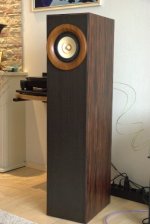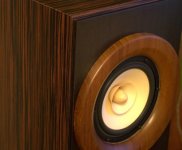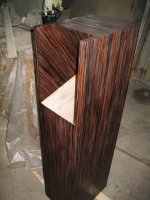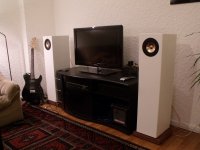I was going to post my full range pics until I saw those sexy bamboo jobs.
referring to himself in the third person:
not all of Chris' work is of the same caliber - be assured there are more sow's ears than silk purses
... but let's not kid ourselves - "green" is one thing - carbon / energy footprint is entirely another...
You can imagine the droves of Chinese (likely female mostly) hand fitting the blocks in the core and then overlaying the strips on the outer layers of the horizontal or vertical grain. Even thou they are cheap labour for the rest of the world, they are raising their standard of living. But wage pressure will keep pushing up those wages. China is where Japan was 30-40 years ago (but i doubt it will take anywhere near that to get to where Japan was 5 years ago).
And cheap diesel has contributed to the economy that let's us ship instead of manufacture locally. Bamboo ply comes across the Pacific, Baltic Birch comes across the Atlantic. That day is ending too... and until such time as those big boats are fueled by fusion reactors (directly or indirectly), it is only going in one direction.
The stranded thou i'm guessing requires a higher level of machine involvement, eventually should be fully automated. And i'd think that a plywood made of alternating grain layers of strand would take this material to a new level. Automation would make it economical to manufacture anywhere it makes sense to grow vast quantities of bamboo... Queensland? I know bamboo will grow in my back yard, but i don't know if it will grow fast enuff.
But once the tech that takes very strong, long bio fibres and make sheet material is sorted and common, one can consider other bio-mass to make board. And one outstanding plant for this, among many candidates, is hemp. And we know that it grows like a weed. I imagine huge swaths of the prairies with 10-20 ft tall fields of fibre hemp.
dave
...Don't get me wrong - even though it's a bear to work with, I love the look you can achieve, but let's not kid ourselves - "green" is one thing - carbon / energy footprint is entirely another
edit: even (most) trees are a renewable resource, just at
a
much
slo
wer
pace
Exactly what I was thinking.
Jeff
Yeah, I understand that he collaborated with some of you in here on the designs. Some of those speakers are really "just" close variants of the microtowers and pensils etc.Kurt is a good guy... and doing some designs i really like 😀
dave
Now if only the prices weren't so steep. Wonder if it's the bamboo?
Indeed Scott & i had a hand in custom designing some of his speakers.
I'm not familiar with Kurt's pricing.
It is hard for diyers to get a handle on what the price tag in the store needs to be for everyone to keep from going bankrupt. Even what a direct from the builder price would be. Took us quite a few builds/sales to get to the point where it became worthwhile (and we are probably still undervaluing what we build).
But DIY, flat-paks and direct purchase from a builder/assembler will, i hope, change the cost/performance ratio for a much larger portion of the population than it has been. More hifi, less money.
dave
I'm not familiar with Kurt's pricing.
It is hard for diyers to get a handle on what the price tag in the store needs to be for everyone to keep from going bankrupt. Even what a direct from the builder price would be. Took us quite a few builds/sales to get to the point where it became worthwhile (and we are probably still undervaluing what we build).
But DIY, flat-paks and direct purchase from a builder/assembler will, i hope, change the cost/performance ratio for a much larger portion of the population than it has been. More hifi, less money.
dave
The main culprit I think is not the building of the speaker itself. It's the finishing job that eats up margins and competitive advantage.
My idea (as I have successfully-ish done with my own iBIBs) is to clad the whole thing in coloured felt. It takes some careful planning and practice, but if done right it gets you a very nice and fresh alternative finish, with much less brute force work than veneering or paint.
My idea (as I have successfully-ish done with my own iBIBs) is to clad the whole thing in coloured felt. It takes some careful planning and practice, but if done right it gets you a very nice and fresh alternative finish, with much less brute force work than veneering or paint.
Hi all
Made my first incursion into FR world with a pair of pensil p70's.
I've been so engrossed with the listening that I've had little time to post the results. They are absolutely amazing!
I used solid Sucupira wood, cut up into 5cm strips and glued together in reverse order to avoid warping, something like the 'butcher block' concept, except done from scratch. I guess it's like buying fillet and asking the butcher to mince it, but I wanted great quality, and don't regret the cost one bit.
Anyway, enough chatter. Here are the pictures.
Made my first incursion into FR world with a pair of pensil p70's.
I've been so engrossed with the listening that I've had little time to post the results. They are absolutely amazing!
I used solid Sucupira wood, cut up into 5cm strips and glued together in reverse order to avoid warping, something like the 'butcher block' concept, except done from scratch. I guess it's like buying fillet and asking the butcher to mince it, but I wanted great quality, and don't regret the cost one bit.
Anyway, enough chatter. Here are the pictures.
An externally hosted image should be here but it was not working when we last tested it.
An externally hosted image should be here but it was not working when we last tested it.
Last edited:
Here are a couple more...
An externally hosted image should be here but it was not working when we last tested it.
An externally hosted image should be here but it was not working when we last tested it.
rather easier to draw than to fabricate - the rabbeting is particularly fiddly
what the photos don't show and what took rather a bit of bother is the perimeter wrap grain matching
This hobby has taught me a few things, such as; cutting wood straight and getting it all to line up is a lot easier said than done, good wood is expensive and it's definitely given me a whole new appreciation for when it's done right. 🙂
Very nice work.
That looks excellent. I must ask, is that veneer the natural colour of the wood or did you stain/dye it to get that beautiful colour?
That looks excellent. I must ask, is that veneer the natural colour of the wood or did you stain/dye it to get that beautiful colour?
It is the veneer called "fine line" from China (like most things in the world🙂). It is natural wood not vinyl but not from the natural eben macasar only imitation from chip wood. The surface is lacquered with 2-componets transparent varnish.
The front panel ist also eben macasar but black. The wooden surround is from mahogany
Looks very similar to material marketed in North America by Brookside Veneers. (Quartered Macassar Ebony in this case) Brookside Veneers Exotic Veneers Wood Veneer Wood Veneers They distribute a wide range of exotic and FSC certified natural veneers, as well as composites from plantation grown species (Aspen, I think), and through considerable manipulation and dyeing, made to emulate a wide range of exotic species. Not inexpensive
- Home
- Loudspeakers
- Full Range
- Full Range Speaker Photo Gallery



